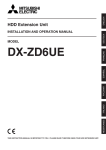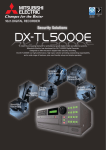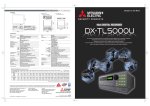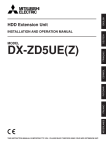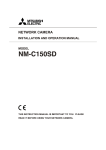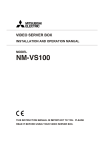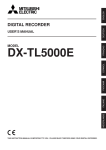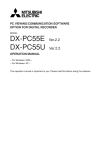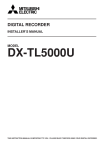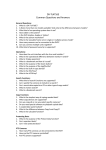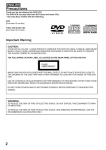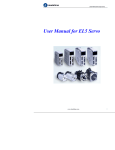Download Mitsubishi DX-KB5UE Operating instructions
Transcript
ENGLISH DEUTSCH FRANÇAIS ESPAÑOL DX-KB5UE PìCCKàâ MODEL ITALIANO INSTALLATION AND OPERATION MANUAL NEDERLANDS KEYBOARD IMPORTANT SAFEGUARDS PLEASE READ ALL THESE INSTRUCTIONS REGARDING YOUR KEYBOARD AND RETAIN FOR FUTURE REFERENCE. FOLLOW ALL WARNINGS AND INSTRUCTIONS MARKED ON THE PRODUCT. 1. Read Instructions All the safety and operating instructions should be read before the product is operated. 2. Retain Instructions The safety and operating instructions should be retained for future reference. 3. Heed Warnings All warnings on the product and in the operating instructions should be adhered to. 4. Follow Instructions All operating and use instructions should be followed. 5. Cleaning Disconnect the DC power cord from the DC IN terminal before cleaning. Do not use liquid cleaners or aerosol cleaners. Use a damp cloth for cleaning. 6. Attachments Do not use attachments not recommended by the product manufacturer as they may cause hazards. 7. Water and Moisture Do not use this product near water – for example, near a bath tub, wash bowl, kitchen sink, or laundry tub, in a wet basement, or near a swimming pool, and the like. 8. Accessories Do not place this product on an unstable cart, stand, tripod, bracket, or table. The product may fall, causing serious injury to a child or adult, and serious damage to the product. Use only with a cart, stand, tripod, bracket, or table recommended by the manufacturer, or sold with the product. Any mounting of the product should follow the manufacturer’s instructions, and should use a mounting accessory recommended by the manufacturer. i 9. Ventilation Slots and openings in the cabinet are provided for ventilation and to ensure reliable operation of the product and to protect it from overheating, and these openings must not be blocked or covered. The openings should never be blocked by placing the product on a bed, sofa, rug, or other similar surface. This product should not be placed in a built-in installation such as a bookcase or rack unless proper ventilation is provided or the manufacturer’s instructions have been adhered to. 10. Power Sources This product should be connected only to its exclusive adapter (DX-EP1E). 11. Object and Liquid Entry Never push objects of any kind into this product through openings as they may touch dangerous voltage points or shortout parts that could result in a fire or electric shock. Never spill liquid of any kind on the product. 12. Servicing Do not attempt to service this product yourself as opening or removing covers may expose you to dangerous voltage or other hazards. Refer all servicing to qualified service personnel. 13. Damage requiring Service Disconnect the DC power cord and all other connections and refer servicing to qualified service personnel under the following conditions: (a) When the power-supply cord or plug is damaged. (b) If liquid has been spilled, or objects have fallen into the product. (c) If the product has been exposed to rain or water. 14. Replacement Parts When replacement parts are required, be sure the service technician has used replacement parts specified by the manufacturer or have the same characteristics as the original part. Unauthorized substitutions may result in fire, electric shock or other hazards. 15. Safety Check Upon completion of any service or repairs to this product, ask the service technician to perform safety checks to determine that the product is in proper operating conditions. 16. Heat The product should be situated away from heat sources such as radiators, heat registers, stoves, or other products (including amplifiers) that product heat. WARNING: TO REDUCE THE RISK OF FIRE OR ELECTRIC SHOCK, DO NOT EXPOSE THIS PRODUCT TO RAIN OR MOISTURE. AVERTISSEMENT: AFIN D’ÉVITER TOUT RISQUE D’INCENDIE OU D’ÉLECTROCUTION, NE PAS EXPOSER CET APPAREIL À LA PLUIE NI À L’HUMIDITÉ. INFORMATION This equipment has been tested and found to comply with the limits for a Class A digital device, pursuant to Part 15 of the FCC Rules. These limits are designed to provide reasonable protection against harmful interference in a regidential installation. This equipment generates, uses, and can radiate radio frequency energy and, if not installed and used in accordance with the instructions, may cause harmful interference to radio communications. Operation of this equipment in a residential area is likely to cause harmful interference in which case the user will be required to correct the interference at his own expense. NOTE THIS CLASS A DIGITAL APPARATUS COMPLIES WITH CANADIAN ICES-003. CET APPAREIL NUMÉRIQUE DE LA CLASSE A EST CONFORME À LA NORME NMB-003 DU CANADA. ii ENGLISH (d) If the product does not operate normally by following the operating instructions. Adjust only those controls that are covered by the operating instructions as an improper adjustment of other controls may result in damage and will often require extensive work by a qualified technician to restore the product to its normal operation. (e) If the product has been dropped or damaged in any way. (f) When the product exhibits a distinct change in performance – this indicates a need for service. Contents IMPORTANT SAFEGUARDS ........................................................................................................ i, ii Caution and care ............................................................................................................................. 3 Major operations and their functions ......................................................................................... 4-6 Top view .................................................................................................................................. 4, 5 Bottom view ................................................................................................................................ 6 Connection ...................................................................................................................................... 7 Initial settings .............................................................................................................................. 8, 9 Setting of the digital recorder ...................................................................................................... 8 Setting of this unit ....................................................................................................................... 8 Mode of this unit ..................................................................................................................... 8, 9 Operating the digital recorder ............................................................................................... 10, 11 Selecting the recorder to be operated ...................................................................................... 10 Switching OUTPUT A and B ..................................................................................................... 10 Multiplexer functions ................................................................................................................. 10 Playback ............................................................................................................................. 10, 11 Controlling PTZ of the camera ..................................................................................................... 12 Selecting the recorder to be operated ...................................................................................... 12 Switching the camera to be controlled ...................................................................................... 12 PTZ control ............................................................................................................................... 12 PTZ help display ....................................................................................................................... 12 Setting the menu of the digital recorder ..................................................................................... 13 Selecting the recorder to be operated ...................................................................................... 13 Setting the menu ...................................................................................................................... 13 Setting the search menu ........................................................................................................... 13 Displaying the help menu ......................................................................................................... 13 Other operations ..................................................................................................................... 14, 15 Selecting the recorder to be operated ...................................................................................... 14 Recording ................................................................................................................................. 14 Lock .......................................................................................................................................... 14 Registering the bookmark ......................................................................................................... 14 ALARM OUT button .................................................................................................................. 14 Checking the connected recorders ........................................................................................... 14 Recorder sequential display ..................................................................................................... 14 Switching to the warning recorder ............................................................................................ 15 Setting the menu of this unit ..................................................................................................... 15 Camera menu help display ....................................................................................................... 15 Trouble shooting ........................................................................................................................... 16 Specifications ................................................................................................................................ 17 2 ENGLISH Caution and care HEAVY OBJECTS SHOULD NEVER BE PLACED ON THE UNIT (E.G., MONITOR) NEVER TOUCH OR INSERT ANY OBJECT INSIDE THE UNIT Touching the inside of the cabinet or inserting foreign objects of any kind not only creates a safety hazard but can also cause extensive damage. MAINTAIN GOOD VENTILATION For maximum ventilation, leave some space around the unit and place the unit on a hard level surface only, and ensure it is not covered during use. Heavy objects should never be placed on the unit. CABINET CARE Never use petroleum-based cleaners. They may cause deterioration or coat flaking of the unit. Clean with a soft cloth moistened with soap and water and wipe dry. When using chemical duster, follow the instructions. PVC cables or leads should not be left in contact with the cabinet surface for long periods. INSTALLATION LOCATION For excellent performance and lasting reliability install in a location that is:1. Well ventilated, out of direct sunlight and away from direct heat. 2. A solid vibration-free surface. 3. Free from high humidity, excessive dust and away from magnetic fields. UNSUITABLE LOCATIONS Placing the unit in the following places might shorten the product life: • Extremely cold places, such as refrigerated warehouses and ice houses. • Places where excessive hydrogen sulfide is likely to be generated, such as hot-springs areas. • Places or locations with salt air environment. This unit complies with the requirements of the EC Directive 89/336/EEC, “EMC Directive,” as amended by Directive 93/68/EEC. The requirements for the susceptibility according to EN 55024 and the requirements for interference according to EN 55022 (Class B) are observed for the operation on residential areas, business, light industrial premises and in small scale enterprises, inside as well as outside of the building. All places of operation are characterised by their connection to the public low voltage power supply system. This unit is manufactured in accordance with EN 60950. POWER CORD USED • The power cords for use in the U.S., the continent of Europe, and U.K. are included with this unit. Use the appropriate one for your country. • The power cord for use in the U.S. is used for 120 V only. Never connect to any outlet or power supply having a different voltage or frequency. POWER SOURCE USED • Be sure to use the supplied AC adapter. HANDLING • Do not place this unit close to other equipment to prevent adverse interference between them. Do not place this unit close to strong magnetized objects. They may cause effects on the pictures or loss of the recorded data. • Never apply volatile substances such as insecticides and do not put rubber or plastic products on the unit for a long period. They may cause deterioration of this unit or flaking of the coating. 3 Major operations and their functions Top view 1 2 3 18 19 4 5 6 7 8 9 10 11 12 13 14 15 16 20 21 2223 24 25 17 26 27 28 29 30 31 32 (When connecting to the digital recorder DX-TL5000 series:) 1 LOCK button Turns on the lock function of this unit. 2 DIGITAL ZOOM button Magnifies the picture when pressed during single screen display or playback. To move the magnification center point, press camera number buttons (11, 14, 15, 16). 3 EMERGENCY button Starts emergency recording. 4 ALARM OUT button Activates the MODE OUT terminal on the digital recorder of which “Mode Out Settings” is set to “LAN.” 5 SEARCH button Displays the <User Menu> of the digital recorder with search function items opened. 6 7 4 SET UP button Displays the <User Menu> of the digital recorder. BOOK MARK button Displays the selection screen for registering the bookmark when pressed during still frame playback of the single screen display. 8 SHIFT button During PTZ operational mode, uses to select the camera to be operated for PTZ function. Uses to switch the operational mode of this unit to keyboard menu setting mode and recorder connection check mode. 9 TRIPLEX PLAY BACK button Switches the digital recorder to triplex playback mode when pressed during split screen display. 10 SEQUENCE button Displays the sequential screen. 11 DVR No. button Uses to select the recorder to be operated. 12 SEQUENTIAL TIME +, – buttons Sets the switching time of the recorder sequential display. 13 INFO. CLEAR button Clears the warning of the digital recorder which is displayed on the LCD display on this unit. 15 OUTPUT A button Switches the multiplexer operating function of this unit to output A. OUTPUT B button Switches the multiplexer operating function of this unit to output B. 26 AUTO PAN button Activates auto pan. ENGLISH 14 HELP button Displays the help menu of the digital recorder. Displays the help menu of the PTZ operational mode or camera menu mode. 27 ZOOM +, – buttons Adjusts the camera zoom. 28 FOCUS +, – buttons Adjusts the focus of the camera. 29 PRESET button Presets up to 16 watching points. 30 IRIS +, – buttons Adjusts the iris of the camera. 16 F1 to F6 buttons Operates the unique functions of each camera connected. 31 PTZ button Uses when switching the operational mode of this unit. 17 LCD display Displays the mode of this unit, and status or recorder number of the digital recorder which is currently connected, etc. 32 Joy stick Uses to pan or tilt the camera. Uses to set the menu of this unit. 18 STOP button Stops playback. 19 PAUSE button Switches the playback to still frame playback when pressed during playback. Displays the still frame playback picture of the end point of the latest recording when pressed during stop mode. 20 JOG dial Forwards or rewinds the picture during playback (frame-by-frame). 21 SHUTTLE ring Adjusts the playback speed, and rewinds or forwards the recorded pictures. 22 REVERSE PLAYBACK button Starts reverse playback. Switches the playback interval. 23 PLAYBACK button Starts playback. Switches the playback interval. 24 SPLIT SCREEN buttons Displays the split screen of the selected type. Uses for setting the menu. 25 1 to 16 buttons Displays the picture of the selected camera number. Selects the digital recorder to be operated. Uses for setting the menu. ON/OFF (camera number 9) button AREA (camera number 13) button Uses when setting the detection area of the motion detection function of the digital recorder. 5 Major operations and their functions (continued) Bottom view 1 1 Rotary switch Used to set the number corresponding to the recorder connected. 2 RS-232C connector Used to connect the device equipped with the RS-232C connector. There is no corresponding device as of now. 3 RS485 connector Used to connect the digital recorder. 4 DC IN 9V connector Used to connect the supplied AC adapter for the power source. 6 2 3 4 ENGLISH Connection (When connecting to the digital recorder DX-TL5000 series:) To household power source (For U. K.) (For U. S.) (For the Continent) Bottom of the keyboard To DC IN 9 V connector Supplied AC adapter (DX-EP1E) To RS485 connector Monitor To VIDEO CASCADE OUT connector To RS485 IN connector Digital recorder DX-TL5000 series Rear panel AUDIO IN IN OUT 1 2 3 4 5 6 7 VIDEO 8 VIDEO 1 2 OPTION SLOT 3 4 Y/C OUTPUT A OUTPUT B CAMERA OUT AUDIO CLAMPER IN OUT 9 10 11 12 13 14 15 OUT 16 IN CASCADE IN AUDIO OUT VIDEO CASCADE SERIAL BUS SERIAL BUS LAN-A LAN-B CLAMPER OFF ON 1 2 3 4 5 6 7 8 9 10 11 12 13 14 15 16 RS-232C 10 100 CLOCK ADJ CLOCK ADJ OUT REC REC STOP EMERGENCY RESERVED MODE OUT 1 + MODE OUT 1 — MODE OUT 2 + MODE OUT 2 — MODE OUT 3 + MODE OUT 3 — MODE OUT 4 + MODE OUT 4 — CALL OUT + CALL OUT — GND MAX 350mA DC 12V OUT ALARM IN 1 2 3 4 5 6 7 8 9 10 11 12 13 14 15 16 MAIN STORAGE ALARM OUT GND COM RS485 OUT 10 RS485 IN RS485 TERM + RS485 TERM — GND RS422 + RS422 — GND RS232 100 RESET ~ AC IN PTZ 100V To RS485 OUT connector To VIDEO CASCADE IN connector To RS485 IN connector To VIDEO CASCADE OUT connector AUDIO IN IN OUT 1 2 3 4 5 6 7 8 VIDEO VIDEO 1 2 OPTION SLOT 3 4 Y/C OUTPUT A OUTPUT B CAMERA OUT AUDIO CLAMPER IN OUT 9 10 11 12 13 14 15 16 OUT IN CASCADE IN AUDIO OUT VIDEO CASCADE SERIAL BUS SERIAL BUS LAN-A LAN-B CLAMPER OFF ON ALARM IN 10 100 CLOCK ADJ CLOCK ADJ OUT REC REC STOP EMERGENCY RESERVED MODE OUT 1 + MODE OUT 1 — MODE OUT 2 + MODE OUT 2 — MODE OUT 3 + MODE OUT 3 — MODE OUT 4 + MODE OUT 4 — CALL OUT + CALL OUT — GND MAX 350mA DC 12V OUT ALARM OUT 1 2 3 4 5 6 7 8 9 10 11 12 13 14 15 16 GND RS-232C 1 2 3 4 5 6 7 8 9 10 11 12 13 14 15 16 MAIN STORAGE COM RS485 OUT 10 RS485 IN RS485 TERM + RS485 TERM — GND RS422 + RS422 — GND RS232 100 RESET ~ AC IN PTZ 100V Up to 16 dgital recorders can be connected. Information of RS485 connection RS485 connector 1 2 3 4 5 6 Pin No. Signal name 1 2 3 4 5 6 GND GND RS485+ RS485RESERVE (open) RESERVE (open) Cable connection GND GND RS485+ RS485RESERVE (open) RESERVE (open) 1 2 3 4 5 6 1 2 3 4 5 6 GND GND RS485+ RS485RESERVE (open) RESERVE (open) 7 Initial settings (When connecting to the digital recorder DX-TL5000 series:) Setting of the digital recorder Setting of the cascade connection Set the cascade connection mode and the recorder address in the <RS-485 Cascade Setting> (System Menu COM/LAN) of the digital recorder. Refer to the manual of the digital recorder for the detailed operation. Setting of this unit Set the rotaly switch on the rear of this unit to 1. Mode of this unit This unit is equipped with following 6 operational modes. Recorder operational mode This is the mode to operate the digital recorder connected. You can operate up to 16 digital recorders when the cascade connection is made. Keyboard menu setting mode This is the mode to set the menu of this unit. Recorder sequential display mode This is the mode to sequentially switch the digital recorder of which picture is displayed at the interval of specified switching time. Recorder connection check mode This is the mode to check the digital recorders connected. PTZ operational mode This is the mode to operate the function of the camera which supports PTZ function and connected to the digital recorder. You can operate the camera which is connected up to 16 digital recorders when the cascade connection is made. (This mode is invalid depending on the camera connected.) Camera menu mode This is the mode to operate the menu of the camera connected. (This mode is invalid depending on the camera connected.) 8 To switch the mode of this unit, press the following button. You can confirm the current mode by checking the LCD display of this unit. Keyboad menu setting mode ENGLISH • SHIFT button + SET UP button SET UP button Display of LCD: KEYBOARD MENU Recorder sequential display mode DVR No. button + SEQUENCE button DVR No. button Recorder operational mode PTZ button Display of LCD: DVR MODE Display of LCD: SEQUENCE Recorder connection check mode PTZ button SHIFT button + DVR No. button PTZ operational mode Display of LCD: PTZ MODE SET UP button Camera menu mode PTZ button Display of LCD: CAM MENU Mode to operate the digital recorder. Mode to operate the camera. any button Mode to set the menu of this unit. Display of LCD: DVR CONNECTION CHECK 9 Operating the digital recorder (When connecting to the digital recorder DX-TL5000 series:) Before operating, set the operational mode of this unit to the mode shown on the right of each function. (Refer to page 9 for setting the operational mode.) Selecting the recorder to be operated 1 2 Recorder operational mode Press the DVR No. button. Press the number button (1 to 16) corresponding to the ID number of the recorder to be operated. Switching OUTPUT A and B Recorder operational mode When the OUTPUT A or OUTPUT B button is pressed, the multiplexer operating function of this unit is switched between OUTPUT A and B. Multiplexer functions Recorder operational mode Single screen display When the number button (1 to 16) is pressed, the picture of the camera connected to the digital recorder is displayed in the single screen. The number of the button corresponds to that of the CAMERA IN terminal on the rear panel of the digital recorder. Split screen display When the SPLIT SCREEN buttons are pressed, the split screen of the selected type is displayed. The different pattern of the selected split screen is displayed each time you press the button. Sequential display When the SEQUENCE button is pressed, the sequential screen is displayed in the screen pattern being displayed. Playback Recorder operational mode Playback/Reverse playback • When the PLAYBACK button is pressed, the recorded contents of the digital recorder is played back. • When the REVERSE PLAYBACK button is pressed, the playback in the reverse direction is started. • When the PLAYBACK button is pressed for the first time after turning on the power of the digital recorder, the playback starts from the oldest recording point. Otherwise, the playback starts from the stopped position of the previous playback. • When the REVERSE PLAYBACK button is pressed for the first time after turning on the power of the digital recorder, the reverse playback starts from the latest recording point. Still frame playback • When the PAUSE button is pressed during playback or reverse playback, the playback switches to still frame playback. • When the button is pressed again, the playback or reverse playback is resumed. • When the PAUSE button is pressed during stop mode, the still frame playback picture of the latest recording point is displayed. Changing the playback speed • When the SHUTTLE ring is turned during playback, reverse playback, or still frame playback, the playback speed is changed. The speed changes on a step of 1 to 4 depending on the angle of the SHUTTLE ring turned. 10 Frame-by-frame playback • When the JOG dial is turned to the right during still frame playback, the frame-by-frame playback in the forward direction is carried out. • When the JOG dial is turned to the left during still frame playback, the frame-by-frame playback in the reverse direction is carried out. • When keeping turning the JOG dial, the continuous frame-by-frame playback is carried out. • When the turning of the JOG dial is stopped, the still frame playback is resumed. Stopping the playback • When the STOP button is pressed during playback, reverse playback, or still frame playback, the playback is stopped. Changing the playback interval • When the PLAYBACK button is pressed during playback or reverse playback, the picture recorded at the long recording interval is played back fast. The playback is made at a speed of 100 pps (for DX-TL5000E)/120 pps (for DX-TL5000U) in total. When the REVERSE PLAYBACK button is pressed, the playback speed becomes slower each time you press the button (up to 0.125 pps). • When the REVERSE PLAYBACK button is pressed during playback or reverse playback, the picture recorded at the short recording interval is played back slowly. The playback is made at a speed of 0.125 pps per camera. When the PLAYBACK button is pressed, the playback speed becomes faster each time you press the button (up to 100 pps (for DX-TL5000E)/120 pps (for DX-TL5000U)). Triplex playback This function is used to insert the playback picture of the desired camera number during split screen display. • When the TRIPLEX PLAY BACK button is pressed during split screen display, the digital recorder is switched to the triplex playback mode. • When the desired camera number button (1 to 16) is pressed within 3 seconds after switching to the triplex playback mode, the playback picture of the selected camera number is displayed. Only the playback picture of the camera number which is being displayed in the split screen can be inserted. • When the STOP button is pressed, the playback is stopped. 11 ENGLISH High speed fast forward/High speed rewind playback • When the SHUTTLE ring is turned to the right for more than 1 second during stop mode, the high speed fast forward playback is carried out. • When the SHUTTLE ring is turned to the left for more than 1 second during stop mode, the high speed rewind playback is carried out. Controlling PTZ of the camera Before operating, set the operational mode of this unit to the mode shown on the right of each function. (Refer to page 9 for setting the operational mode.) Selecting the recorder to be operated 1 2 Switching the camera to be controlled • Recorder operational mode Press the DVR No. button. Press the number button (1 to 16) corresponding to the ID number of the recorder to be operated. The PTZ function of the camera connected to that recorder can be controlled. PTZ operational mode During split screen display, switch the mode of this unit to PTZ operational mode. Press the SHIFT button and then press the camera number button (1 to 16) to be controlled. Only the cameras of which picture is being displayed in the split screen can be switched. PTZ control PTZ operational mode Tilt Tilt the joy stick to the upward direction to adjust the camera angle upward. Tilt the joy stick to the downward direction to adjust the camera angle downward. Pan Tilt the joy stick rightward or leftward to pan the camera. Camera zoom Press the ZOOM + button (tele) or ZOOM – button (wide) to adjust the camera zoom. Focus Press the FOCUS + button (far) or FOCUS – button (near) to adjust the focus of the camera. Iris Press the IRIS + button (close) or IRIS – button (open) to adjust the iris of the camera. Preset Press the PRESET button and then press the number button (1 to 16) within 3 seconds to preset the watching points. Up to 16 points can be set. Auto pan Press the AUTO PAN button to carry out the auto pan. PTZ help display • • 12 PTZ operational mode When the HELP button is pressed during PTZ operational mode, the assignment of buttons for operating the unique function of the selected camera is shown on the LCD display. Each time the HELP button is pressed, the next line is appeared. ENGLISH Setting the menu of the digital recorder Before operating, set the operational mode of this unit to the mode shown on the right of each function. (Refer to page 9 for setting the operational mode.) Selecting the recorder to be operated 1 2 Setting the menu • • • Recorder operational mode Press the SET UP button to display the <User Menu> of the digital recorder. The following buttons are used to set the menu. – SPLIT SCREEN buttons : Used to operate the buttons on the menu screen which are shown with the alphabets A to E. – 1 to 16 buttons : Used to operate the buttons on the menu screen which are shown with the figures 1 to 16. Setting the search menu • Recorder operational mode Press the DVR No. button. Press the number button (1 to 16) corresponding to the ID number of the recorder to be operated. Recorder operational mode Press the SEARCH button to display the <User Menu> of the digital recorder with the search function items opened. The following buttons are used to set the menu. – SPLIT SCREEN buttons : Used to operate the buttons on the menu screen which are shown with the alphabets A to E. – 1 to 16 buttons : Used to operate the buttons on the menu screen which are shown with the figures 1 to 16. Displaying the help menu Recorder operational mode Press the HELP button to display the help menu of the digital recorder which shows the caution on use, operating method, or explanation on functions. The help menu can be displayed even while the menu screen is displayed. 13 Other operations Before operating, set the operational mode of this unit to the mode shown on the right of each function. (Refer to page 9 for setting the operational mode.) Selecting the recorder to be operated 1 2 Recorder operational mode Press the DVR No. button. Press the number button (1 to 16) corresponding to the ID number of the recorder to be operated. Recording Recorder operational mode When the EMERGENCY button is pressed, the emergency recording starts. Lock • Recorder operational mode When the LOCK button is pressed, the lock function of this unit is turned on. Registering the bookmark Recorder operational mode When the BOOK MARK button is pressed during the still frame playback of the single screen, the selection screen is displayed and the bookmark can be registered. • The following buttons are used to set the menu. – SPLIT SCREEN buttons : Used to operate the buttons on the menu screen which are shown with the alphabets A to E. – 1 to 16 buttons : Used to operate the buttons on the menu screen which are shown with the figures 1 to 16. ALARM OUT button Recorder operational mode When the ALARM OUT button is pressed, the MODE OUT terminal on the digital recorder of which “Mode Out Settings” is set to “LAN” is activated. By using this button, you can remotely control the device connected to the MODE OUT terminal of the digital recorder. Checking the connected recorders • Recorder sequential display • • • 14 Recorder connection check mode When this unit is switched to recorder connection check mode, the number buttons (1 to 16) corresponding to the connected recorder numbers are illuminated, and you can check the digital recorders which are currently connected. Recorder sequential display mode When this unit is switched to recorder sequential display mode, the recorder of which picture is displayed switches sequentially at the interval of specified switching time (default setting is 5 seconds). When the SEQUENTIAL TIME +, – button is pressed, the switching time is changed between the range of 2 to 60 seconds. When the DVR No. button is pressed, the mode of this unit is resumed to the recorder operational mode. Recorder operational mode Recorder connection check mode Recorder sequential display mode PTZ operational mode • • • When this unit receives the warning of the digital recorder, this unit connects to that recorder automatically. When the INFO. CLEAR button is pressed, the warning is cleared. Set “WARNING ON/OFF” menu to “ON” to activate this function. Setting the menu of this unit • • • Menu item WARNING ON/OFF Setting item ON OFF KEY SOUND ON/OFF ON OFF Camera menu help display • • Keyboad menu setting mode Tilt the joy stick upward or downward to select the menu item. Tilt the joy stick leftward or rightward to select the setting item. When the SET UP button is pressed, the setting is determined and the recorder operational mode is resumed. Function Automatically connects to the warning recorder. Does not automatically connect to the warning recorder although the warning is displayed on the LCD display. Turns on the key sound of this unit. Turns off the key sound of this unit. Camera menu mode When the HELP button is pressed during camera menu mode, the assignment of buttons for operating the menu of the selected camera is shown on the LCD display. Each time the HELP button is pressed, the next line is appeared. 15 ENGLISH Switching to the warning recorder Trouble shooting If problems with the unit persist even after you have followed the suggestions below, disconnect the power cord and contact the retailer from whom you purchased the unit. Description of problem Consult the following The recorder cannot be controlled. • • • • • The power cannot be turned on. • Is the AC adapter connected correctly? The recorder cannot be selected. • • • • The camera cannot be controlled. • Is the connection made correctly? Check the RS485 and RS-232C connections between the digital recorder and the camera. • Is the power of the recorder turned on? • Is the <PTZ Setting> menu of the recorder set correctly? 16 Is the connection made correctly? Is the power of the recorder turned on? Is the cascade recorder address set? Is the desired recorder selected? Is the recorder in cascade mode? Is the connection made correctly? Is the power of the recorder turned on? Is the cascade recorder address set? Is the recorder in cascade mode? AC Adapter (DX-EP1E) Class Rated power supply Maximum current Rated output Dimensions Weight AC adapter 100-240 V AC; 50/60 Hz 1.0 A DC 9 V, 1.67 A 56 (W) X 25.5 (D) X 85 (H) mm (excluding the cord) 0.3 kg (including the AC adapter and cord) DX-KB5UE Rated power supply Rated input Operation temperature Relative humidity Altitude Dimensions Weight DC 9 V 0.5 A 41 ºF to 104 ºF (5 ºC to 40 ºC) Max. 80 % Max. 2000 m 365 (W) X 201 (D) X 94 (H) mm 2.0 kg Control terminal RS-485 port Serial port Accessories ENGLISH Specifications RS-485 Output RJ-11 RS-232C D-SUB 9 pin 3 AC power cords (for U. K./for the Continent/for U. S.) 1 AC adapter (DX-EP1E) 17 MITSUBISHI DIGITAL ELECTRONICS AMERICA, INC. 9351 Jeronimo Road, Irvine, CA 92618, U.S.A. Phone 949-465-6000 www.mitsubishi-imaging.com Tech Support 888-307-0309 [email protected] UK Mitsubishi Electric Europe B.V. UK Branch Office Visual Information Systems Division Travellers Lane Hatfield Herts AL10 8XB Telephone: +44 (1707)-278 684 Fax: +44 (1707)-278 541 GERMANY Mitsubishi Electric Europe B.V. German Branch Office Electric Visual Systems Gothaer Str. 8 40880 Ratingen Germany Telehone: +49 (2102)-486 9250 Fax: +49 (2102)-486 7320 SPAIN Mitsubishi Electric Europe B.V. Spanish Branch Office Ctra. de Rubi, 76-80 Apdo.420 08190 Sant Cugat del Valles (Barcelona) SPAIN Telephone: +34 (93)-565 3154 Fax: +34 (93)-589 4388 FRANCE Mitsubishi Electric Europe B.V. French Branch Office 25, Boulevard des Bouvets 92741 Nanterre Cedex Telephone: +33 (1)-5568 5500 Fax: +33 (1)-5568 5731 872C356A6 PRINTED IN MALAYSIA ITALY Mitsubishi Electric Europe B.V. Italian Branch Office Centro Direzionale Colleoni Palazzo Perseo - Ingresso 2, Via Paracelso 12, 20041 Agrate Brianza, Italy Telehone: +39 (039)-605 31 Fax: + 39 (039)-605 3214 The Netherlands Mitsubishi Electric Benelux A Division of Mitsubishi Electric Europe B.V. Niiverheidsweg 23A, 3641 RP Mijdrecht Netherlands. Telephone: +31 (297)-282 461 Fax: +31 (297)-283 936 Sweden Mitsubishi Electric Scandinavia Hammarbacken 14 Box750 SE-191 27 Sollentuna Sweden Telephone: +46 (8)-625 1000 Fax: +46 (8)-35 1132 Ireland Mitsubishi Electric Ireland A Division of Mitsubishi Electric Europe B.V. Westgate Business Park, Ballymount, Dublin 24. Ireland Telephone: +353 (1)-419 8800 Fax: +353 (1)-419 8895




















